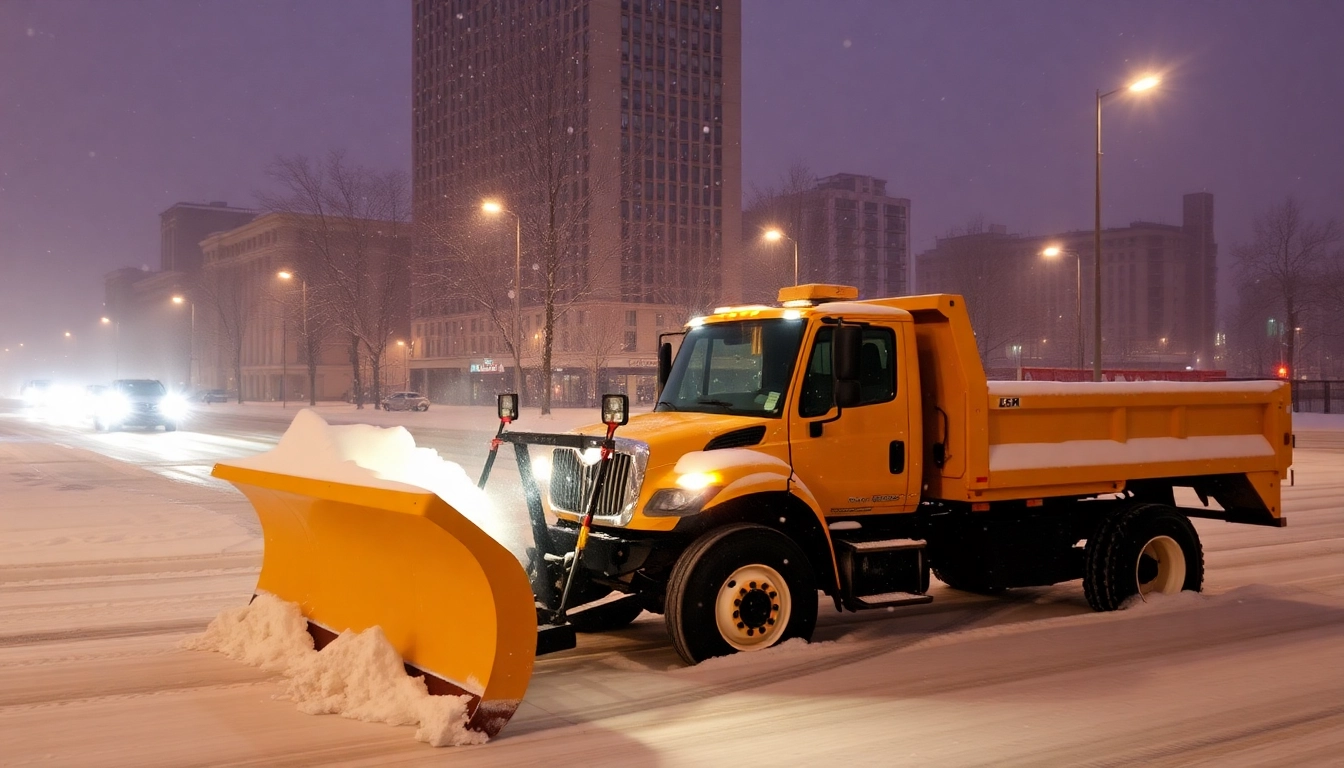Understanding Snow Plowing Basics
Snow plowing is an essential service during the winter months, especially in regions that experience heavy snowfall. It involves the removal of snow from roads, driveways, and other surfaces using specialized vehicles equipped with plows. This practice not only ensures the safety of drivers and pedestrians but also helps maintain accessibility to homes and businesses. For those seeking reliable snow plowing services, understanding the basics is crucial. In this section, we delve into the definitions, tools, and common challenges faced by those in the snow plowing industry.
What is Snow Plowing?
Snow plowing is the process of clearing snow from surfaces, typically using a truck or similar vehicle equipped with a robust plow blade. This operation often takes place after significant snowfall when roads and pathways become unsafe or impassable. Snow plowing primarily focuses on pushing the snow off the surface rather than completely removing it. This method allows for quicker access and ensures that the snow does not accumulate to dangerous levels on critical routes.
Tools and Equipment for Snow Plowing
Successful snow plowing operations rely on a variety of tools and equipment. The primary piece of equipment is, of course, the snow plow itself. Different types of plows include:
- Straight Blade Plows: These are the most common and can be angled left or right to push snow to the sides.
- V-Plows: These have a V-shaped design, allowing for greater snow displacement and versatility in managing snow drifts.
- Box Plows: Ideal for clearing large areas efficiently, these are used mostly in commercial settings.
- Snow Blowers: For tighter spaces, snow blowers are used to throw snow away from the cleared area.
In addition to the plows, other essential equipment includes trucks capable of carrying the load, salt spreaders for de-icing, and sometimes front-end loaders for larger snow removal tasks.
Common Challenges Faced in Snow Plowing
While snow plowing is vital for winter safety and accessibility, it comes with its own set of challenges. These include:
- Severe Weather Conditions: Heavy snowfall and blizzards can make plowing operations difficult and dangerous.
- Visibility Issues: High winds can lead to snow drifts and reduced visibility, complicating plowing efforts.
- Traffic Congestion: Busy roads can hinder snow plowing operations, causing delays and unsafe conditions.
- Equipment Failures: Mechanical issues can lead to missed plowing schedules, impacting safety and accessibility.
Best Practices for Snow Plowing
Knowing the best practices is crucial for effective snow plowing operations. Here, we discuss recommended strategies for both residential and commercial snow clearing. These practices not only ensure efficiency but also prioritize safety for both plow operators and the public.
Effective Techniques for Residential Areas
For residential snow plowing, the focus is on clearing driveways, sidewalks, and private roads to ensure safe access for residents. Effective techniques include:
- Planning Routes: Assess which areas receive the most traffic and prioritize them during plowing.
- Using Smaller Equipment: In tighter spaces, smaller vehicles with adjustable plows are advisable.
- Snow Stacking: Instead of pushing snow to the side, consider stacking it in designated areas to maximize space.
Commercial Snow Plowing Strategies
Commercial properties often require a more comprehensive approach due to their scale and the need for prompt service. Effective strategies can involve:
- Using Advanced Forecasting Tools: Technological assistance can help in predicting snow patterns and scheduling clearing operations.
- Routine Maintenance: Regularly servicing plow equipment ensures reliability during operation.
- Water and Salt Mix: In some cases, a mixture of salt and water is applied before a storm as a preventive measure to facilitate easier snow removal afterward.
Safety Measures During Snow Plowing
Safety should always be a priority during snow plowing operations. Some key safety measures include:
- Training for Operators: Proper training and certification help minimize accidents and improve efficiency.
- Using Proper Lighting: Equipping vehicles with proper lighting enhances visibility during low-light conditions.
- Adhering to Local Regulations: Following local laws regarding snow removal is crucial for avoiding fines and ensuring community safety.
Cost Factors in Snow Plowing Services
Understanding the costs associated with snow plowing is essential for homeowners and businesses alike. Several factors contribute to pricing, and this section breaks down average costs, contributing factors, and different payment structures.
Average Pricing Models for Snow Plowing
The cost of snow plowing can vary widely based on geographic location, service frequency, and the size of the area being cleared. On average:
- Per Visit: Many homeowners pay between $45 to $160 for a single snow plowing visit.
- Seasonal Contracts: For more comprehensive service, annual contracts can range from $300 to $1,000 depending on the expected snowfall amount.
Factors Influencing Snow Plowing Costs
Several factors can influence the pricing of snow plowing services, including:
- Location: Urban areas typically have higher rates due to increased demand and operational costs.
- Snow Amount: Heavy snowfall may require additional visits, increasing overall costs.
- Type of Surface: The type of surface being cleared impacts efficiency; asphalt may need different techniques compared to concrete.
Seasonal Contracts vs. Pay-Per-Service
When considering snow plowing services, it’s essential to weigh the benefits of seasonal contracts against pay-per-service arrangements:
- Seasonal Contracts: Ideal for those in regions with heavy snowfall. Costs are predictable and often include comprehensive services.
- Pay-Per-Service: More flexible, allowing homeowners to pay only for the services they require but can lead to higher costs during heavy snowfall periods.
The Importance of Timely Snow Plowing
Timely snow plowing is critical not only for safety but also for maintaining accessibility during severe winter weather. This section emphasizes the reasons behind prompt snow clearing services.
Impact on Public Safety
Snow-covered roads and walkways can lead to slips, falls, and accidents. Timely snow plowing minimizes these risks by:
- Ensuring Clear Roads: Reduces the likelihood of vehicular accidents during winter conditions.
- Improving Visibility: Well-cleared streets provide better visibility for drivers, enhancing safety.
Effects on Property Accessibility
For businesses and residential areas, accessibility is paramount. Timely snow plowing aids in:
- Customer Access: Ensuring customers can access commercial properties safely.
- Emergency Services: Quick access for medical and emergency services in case of an emergency.
Economic Considerations of Snow Plowing
Beyond safety, snow plowing plays a vital role in the economy. Clear roads ensure goods and supplies can be delivered on time, while businesses can remain open during winter months. Delays in snow removal can have significant economic impacts, leading to losses for local businesses and additional costs for municipal services.
Frequently Asked Questions About Snow Plowing
As snow plowing is essential yet often misunderstood, this section addresses some frequently asked questions to clarify common misconceptions and provide valuable insights.
Snow Plowing vs. Snow Removal
One common question is the difference between snow plowing and snow removal. While both terms involve snow management, the distinction lies in their methods:
- Snow Plowing: This refers to the act of moving snow from one area to the sides of a road or surface without removing it entirely.
- Snow Removal: This involves the complete process of collecting snow and hauling it away, a more extensive and often more costly service.
How to Choose a Snow Plowing Service
Selecting a reliable snow plowing service requires careful consideration. Key factors to evaluate include:
- Reputation: Look for customer reviews and testimonials to gauge the service quality.
- Licensing and Insurance: Ensure the company is licensed and insured to avoid liabilities.
- Response Time: A quick response time is crucial, especially after heavy snowfall.
Snow Plowing Regulations and Responsibilities
Many municipalities have snow plowing regulations that dictate how and when snow must be cleared from public pathways. Homeowners may also have specific responsibilities, such as clearing sidewalks adjacent to their properties. Understanding local laws is essential for compliance and to avoid fines.



